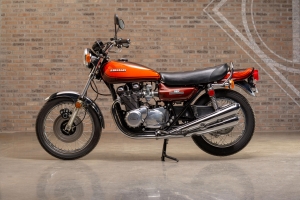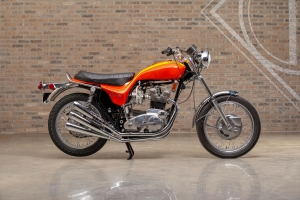The 1970’s were not only known for the explosion of high-performance Muscle Cars, but the introduction of a new segment of production motorcycles called Superbikes.
Leading that charge was the 1969 Honda CB750. Featuring an inline four-cylinder, single overhead-cam, four-carburetor engine displacing 736cc, the bike was the product of Honda’s earlier racing success and targeted squarely at the American market. Creature comforts such as an electric starter, dual mirrors, flashing turn signals, and a kill switch completed the package. Introduced for the first time on a production motorcycle was the addition of a front disc brake. Priced at $1,495 it was a technological tour-de-force, which Cycle World magazine in August of 1969 called “the most sophisticated production bike ever.”
Though called a standard (or now referred to as Universal Japanese Motorcycle) for its upright layout and wide handlebars, there was no mistaking the sporting intent of this motorcycle. About that time, the American Motorcycle Association’s Competition Committee updated their class specifications and opened the door for the large-displacement, 750cc-class that would become known as the first Superbikes.
Just like in the Muscle Car world, this competition incited an arms race on the showroom floor. Kawasaki, which had been in development of its own four-cylinder 750cc motorcycle when the CB750 first broke cover, went back to their drafting tables, increasing the displacement of their bike to 900cc. The project was code named “New York Steak,” and the resulting Z1900 would first be released in 1972 as the largest displacement and most powerful Japanese motorcycle ever built.

The Z1900 featured disc brakes and the world’s first widely-produced double overhead-cam production engine. The bike would set the AMA and FIM 24-hour endurance world record at Daytona, logging 2,631 miles at an average speed of 109.64 mph. The Society of Automotive Engineers of Japan has recognized the 1972 Z1 as one of their 240 Landmarks of Japanese Automotive Technology.
Now firmly installed in the American market and mindset, others joined the Superbike fray. The British motorcycle manufacturers, which had dominated production only two decades earlier, were forced to respond. BSA/Triumph’s 750cc Trident attempted to overcome its aging engine with contemporary styling by Craig Vetter as the X-75 Hurricane. Norton raised its displacement from 750cc to 850cc, and introduced an electric starter and smooth-riding elastometric engine mounts for its top-of-the-line offering, the Commando.

But it was clear the era of British motorcycles was on the wane, as the Japanese manufacturers now firmly grabbed the advantage in styling, performance, reliability, and affordability. Once in the lead, they never looked back.
Both the CB750 and Z1900, both initially risky propositions in a new market segment, would continue to be sold for decades, and their basic engine architectures became the standard of the industry. The Throttlestop Museum is proud to have on display two very fine examples of these early Superbikes; survivors of a street war that forever changed motorcycling history.